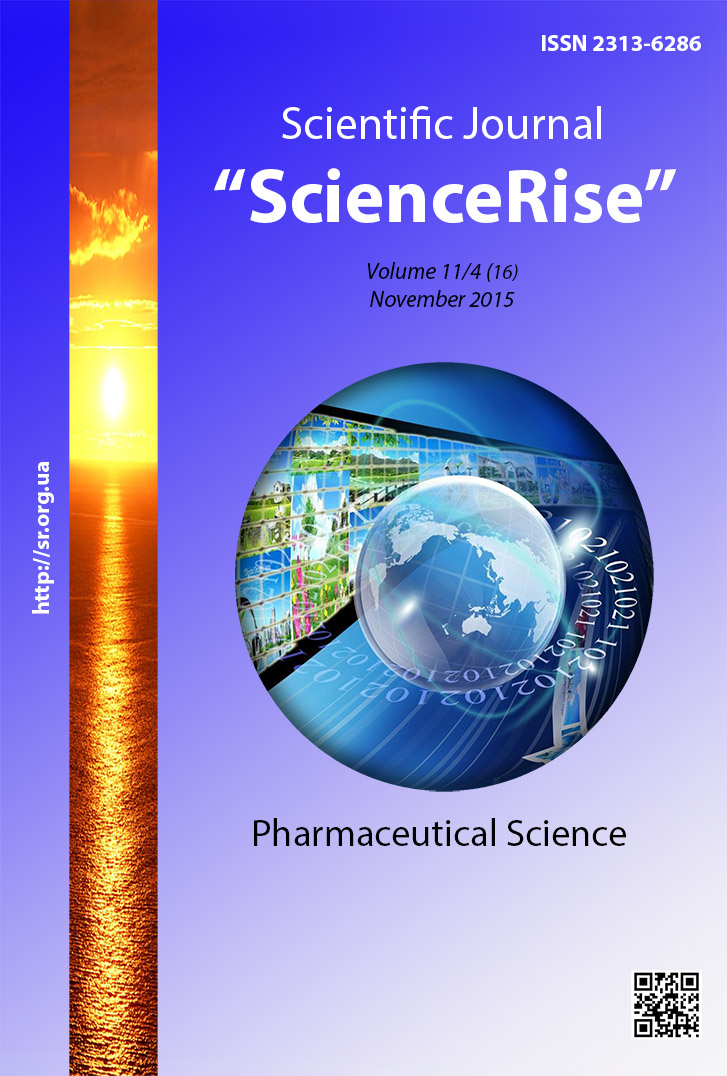Synthesis of the ensembles from succinylated interleukin-2 derivatives and their biological activity in vitro
DOI:
https://doi.org/10.15587/2313-8416.2015.53985Keywords:
Agilent-2100, bioactivity, succinylated interleukin-2, high-performance liquid chromatography, recombinant interleukin-2Abstract
Purpose: The biological activity (direct anticancer action in vitro) of combinatorial IL-2 succinylated derivatives was examined. Acylation of IL-2 was performed using succinic anhydride with various levels of acylation, with the formation of a complex assembly of many derivatives (self-assembled quasi-living structure).
Methods: In the study, we used recombinant interleukin-2 (IL-2) (Ronkoleukin, Russia) in oxidizing form and other reagents from Sigma-Aldrich and Fluka (USA). For acylation, recombinant IL-2 in the form of a matrix fluid with a protein concentration of 0.6 mg/ml was used. The IL-2 matrix solution was brought to a pH of 8.0 through the addition of a 0.01% solution of sodium hydroxide. The synthesized ensemble of succinyl-IL-2 was analyzed using the capillary gel electrophoresis method in an Agilent-2100 bioanalyzer. The molecular masses of the synthesized ensemble were established in comparison to standard samples of low-molecular proteins with known molecular masses that were part of the bioanalyzer’s collection. The additional negative charge of the modified IL-2 was determined by a FPLC (Fast Protein Liquid Chromatography) system from Pharmacia (Woerden, Netherlands). CTLL-2, a murine IL-2-dependent cell line, was obtained fromBiokontrol (Kiev, Ukraine). These respondingcells were used in proliferative assays comparing the activityof the IL-2 and succinylated IL-2 derivatives to the WHO InternationalStandard. For statistical data analysis, the one-way ANOVA was used.
Results: After treatment with Suc-IL-2, BTL were studied in vitro on the CTLL-2 cell line, dose-dependently, in a BTL induction reaction. The highest level of biological activity in acylated IL-2 was observed in Suc-IL-2 with four modified lysine residues. In conclusion, succinylated IL-2 with four substituted lysines may be useful as a prospective anticancer agent.
Conclusions: Ten-fold increase in the biological activity of IL-2 was observed after partial succinylation. This phenomenon can be used in the further IL-2 drugs biotechnological development for increasing the concentration of the main active substance in medicinal form
References
Adibzadeh, M., Weder, H. G., Rehbein, A., Schwuléra, U., Obermeier, J., Pawelec, G. (1992). Activity of liposomal interleukin-2 in vitro. Mol. Biother. 4 (1), 24–28.
Okuno, K., Nakamura, K., Tanaka, A., Yachi, K., Yasutomi, M. (1998). Hepatic immunopotentiation by galactose-entrapped liposomal IL-2 compound in the treatment of liver metastases. Surg Today, 28 (1), 64–69. doi: 10.1007/bf02483610
Apisarnthanarax, N., Talpur, R., Duvic, M. (2002). Treatment of Cutaneous T Cell Lymphoma. American Journal of Clinical Dermatology, 3 (3), 193–215. doi: 10.2165/00128071-200203030-00006
Martynov, A. V., Smelyanskaya, M. V. (2005). Antiproliferative Properties of Chemically Modified Recombinant IFN-α2b. Journal of Interferon & Cytokine Research, 25 (7), 414–417. doi: 10.1089/jir.2005.25.414
Koppenhagen, F. J., Storm, G., Underberg, W. J. M. (1998). Development of a routine analysis method for liposome encapsulated recombinant interleukin-2. Journal of Chromatography B: Biomedical Sciences and Applications, 716 (1-2), 285–291. doi: 10.1016/s0378-4347(98)00271-0
Hank, J. A., Surfus, J., Gan, J., Albertini, M., Lindstrom, M., Schiller, J. H., Hotton, K. M., Khorsand, M., Sondel, P. M. (1999). Distinct Clinical and Laboratory Activity of Two Recombinant Interleukin-2 Preparations. Clin. Cancer Res., 5 (2), 281–292.
Arkin, M. R., Randal, M., DeLano, W. L., Hyde, J., Luong, T. N., Oslob, J. D. et. al (2003). Binding of small molecules to an adaptive protein-protein interface. Proceedings of the National Academy of Sciences, 100 (4), 1603–1608. doi: 10.1073/pnas.252756299
Rosenberg, S. A. (1988). New Approaches to the Immunotherapy of Cancer Using Interleukin-2. Annals of Internal Medicine, 108 (6), 853. doi: 10.7326/0003-4819-108-6-853
Kohler, P. C., Hank, J. A., Moore, K. H., Storer, B., Bechhofer, R., Sondel, P. M. (1987). Phase I clinical evaluation of recombinant interleukin-2. Prog. Clin. Biol. Res., 244, 161–172.
Lotze, M. T., Matory, Y. L., Rayner, A. A., Ettinghausen, S. E., Vetto, J. T., Seipp, C. A., Rosenberg, S. A. (1986). Clinical effects and toxicity of interleukin-2 in patients with cancer. Cancer, 58 (12), 2764–2772. doi: 10.1002/1097-0142(19861215)58:12<2764::aid-cncr2820581235>3.0.co;2-z
Gearing, A. J. H., Thorpe, R. (1988). The international standard for human interleukin-2. Journal of Immunological Methods, 114 (1-2), 3–9. doi: 10.1016/0022-1759(88)90145-7
Salunkhe, S., Soorapaneni, S., Prasad, K. S., Raiker, V. A., Padmanabhan, S. (2010). Strategies to maximize expression of rightly processed human interferon α2b in Pichia pastoris. Protein Expression and Purification, 71 (2), 139–146. doi: 10.1016/j.pep.2010.02.007
Cohen, J. (1992). A power primer. Psychological Bulletin, 11 2(1), 155–159. doi: 10.1037/0033-2909.112.1.155
Arkin, M. R., Randal, M., DeLano, W. L., Hyde, J., Luong, T. N., Oslob, J. D. et. al (2003). Binding of small molecules to an adaptive protein-protein interface. Proceedings of the National Academy of Sciences, 100 (4), 1603–1608. doi: 10.1073/pnas.252756299
Downloads
Published
Issue
Section
License
Copyright (c) 2015 Artur Martynov, Boris Farber, Sophia Farber, Tatiana Kabluchko

This work is licensed under a Creative Commons Attribution 4.0 International License.
Our journal abides by the Creative Commons CC BY copyright rights and permissions for open access journals.
Authors, who are published in this journal, agree to the following conditions:
1. The authors reserve the right to authorship of the work and pass the first publication right of this work to the journal under the terms of a Creative Commons CC BY, which allows others to freely distribute the published research with the obligatory reference to the authors of the original work and the first publication of the work in this journal.
2. The authors have the right to conclude separate supplement agreements that relate to non-exclusive work distribution in the form in which it has been published by the journal (for example, to upload the work to the online storage of the journal or publish it as part of a monograph), provided that the reference to the first publication of the work in this journal is included.

